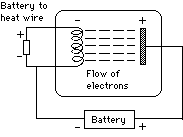|
[an error occurred while processing this directive]
#4. Electrons
|
(Files in red–history)
|
How do we know?One clue comes from the "Edison effect," discovered by Thomas Alva Edison. Imagine a glass bulb from which air has been pumped, until hardly any of it remains. In one end we embed a metal coil of wire (like that of a flashlight bulb) in the other a metal plate, as drawn. Connect now an electric battery (drawn at the bottom) between the coil and the plate, so that the former is negative and the latter is positive, say at +100 volts.
No current will flow in this circuit: some atoms or molecules may be left inside the bulb, but they are electrically neutral, and can carry no electric current. Air is an excellent insulator: electric companies can string power lines in the open air and never have to worry about currents dribbling out on their way from the power station to consumers.
|
|
Now connect a small second battery (on the left) to the end of the coil, so that a current flows through the coil and heats it up. As the wire begins to glow, a current begins to flow, because now negatively charged particles are emitted from the hot wire, are attracted to the positive charge on the plate and by doing so, complete the electrical circuit. Suppose the connections of the first battery are reversed, so that now the coil is positive and the plate is negative. Then no current flows, showing that the hot wire releases only negative particles, not positive ones. These particles were named electrons In laboratory experiments these particles were directed by electrically charged structures (similar to the "electron guns" inside TV picture tubes) to form beams. Those beams were then bent by magnets and by electrified plates, and their behavior was studied. From such experiments and others the mass of the emitted particles, which became known as "electrons", could be determined. It turned out that they were rather lightweight. The simplest atom, that of hydrogen, contains a central positive particle, a proton, and a single electron, and the proton is nearly 2000 times heavier. |
Questions from Users:
*** What is the smallest magnet possible?
*** Harvesting electrons from power lines?
Next Stop: #4H. History of the Electron
- Back to the Index Page
Timeline Expanded timeline Glossary
Author and Curator: Dr. David P. Stern
Mail to Dr.Stern: education("at" symbol)phy6.org
Co-author: Dr. Mauricio Peredo
Spanish translation by J. Méndez
Re-formatted 3-10-2006

